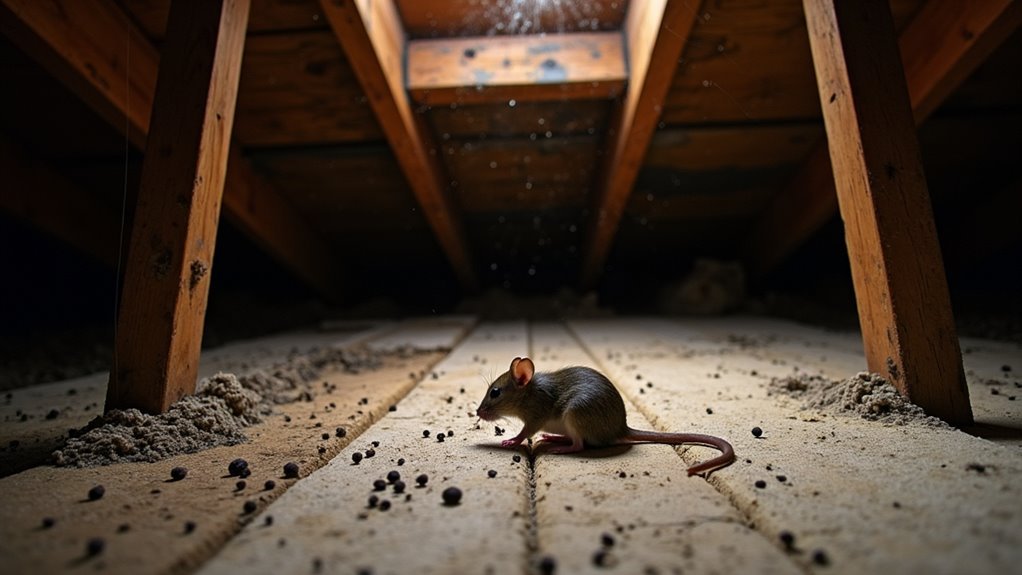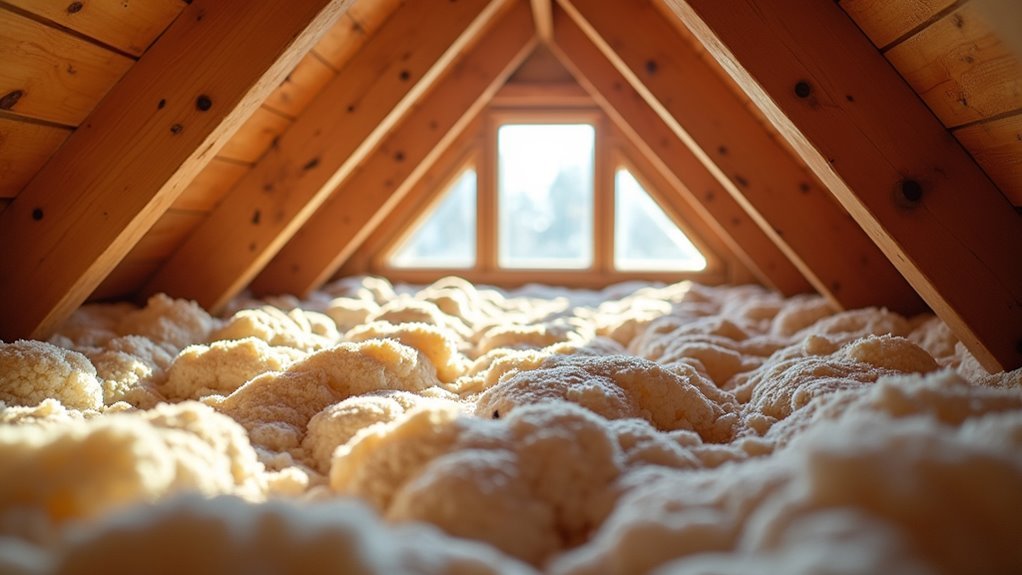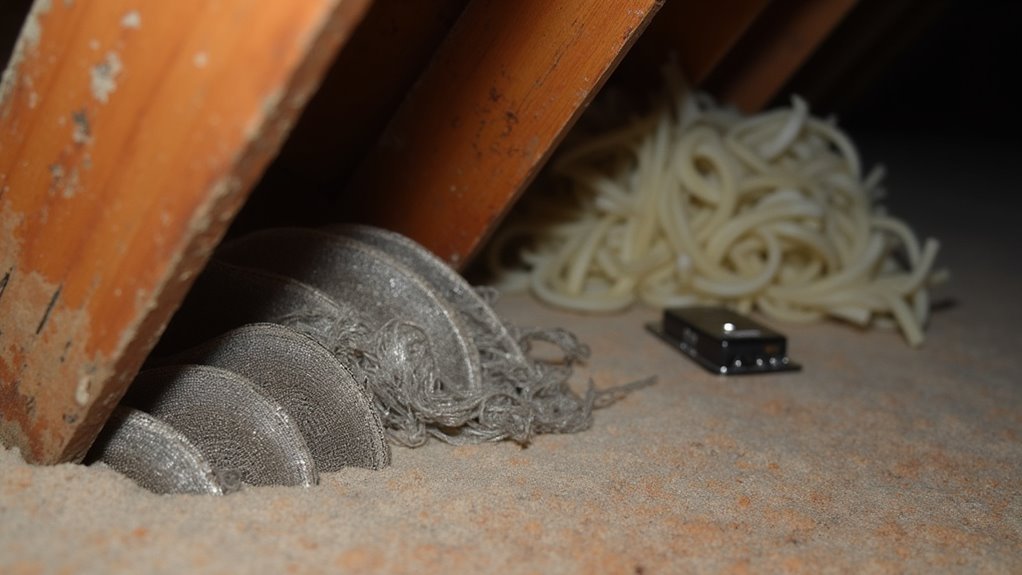You can keep pests out of your attic by sealing entry points as small as a dime using steel mesh or hardware cloth, since rodents can squeeze through surprisingly tiny gaps. Install fine-mesh screens over vents to block insects while maintaining airflow, and keep your attic clean by replacing cardboard storage with sealed plastic containers. Control moisture with proper ventilation and use natural repellents like peppermint oil around potential entry points. These extensive strategies will help you discover additional protective measures.
Signs That Indicate Pests Have Already Invaded Your Attic

While many homeowners assume their attics remain undisturbed, several telltale signs can reveal that unwanted pests have already taken up residence in this often-overlooked space.
You’ll likely hear scratching, scuttling, or squeaking sounds, especially at night when most attic pests become active.
Check for droppings throughout the area – mice leave rice-shaped pellets while raccoons produce larger droppings resembling small dog waste.
Animal droppings serve as the most reliable indicator of pest activity, with size and shape revealing which species have invaded your attic space.
Examine your insulation, wiring, and wooden structures for visible damage like chew marks or shredded materials indicating an active infestation.
You might notice unpleasant odors from droppings or decaying animals, particularly with species like opossums.
Finally, discovering nests constructed from twigs, leaves, or soft materials suggests animals are preparing to raise young, signaling a more established problem.
Sealing Entry Points to Block Pest Access
Once you’ve confirmed pests have invaded your attic, your next priority becomes preventing future intrusions by blocking their access routes.
Start by thoroughly inspecting walls, roofs, and foundations for gaps. Rodents can squeeze through openings as small as a dime, so examine every potential entry point carefully.
Use steel mesh or hardware cloth to seal holes rather than softer materials that pests can easily gnaw through.
Install fine-mesh screening over attic vents to block insects and small rodents while maintaining proper ventilation.
Don’t overlook damaged screens or vents, as these compromised openings become easy access points for shelter-seeking pests.
Schedule regular attic inspections to identify new holes or signs of wear, then address these entry points immediately to maintain your pest-proof environment.
Installing Proper Attic Ventilation Screens

After sealing entry points throughout your attic, installing proper ventilation screens becomes your next critical defense against pest intrusion.
Fine-mesh screening on your attic vents effectively blocks rodents, birds, and insects while maintaining essential airflow for temperature and moisture control.
Choose durable materials like hardware cloth or stainless steel that won’t rust or deteriorate under weather exposure.
These screens must balance protection with ventilation—blocking pests without restricting airflow that keeps your attic cool and dry.
Install screens securely over all vent openings, ensuring no gaps remain. Even small openings can invite unwanted visitors.
Inspect your screens regularly for damage or wear, replacing them when necessary.
Combine screen installation with thorough gap sealing around vents for maximum protection against pest infiltration.
Maintaining Clean and Clutter-Free Attic Spaces
You’ll need to remove any stored food items from your attic, as they attract rodents and insects looking for easy meals.
Clear out old boxes, papers, and other materials that pests can use for nesting, replacing cardboard storage with sealed plastic containers.
Don’t forget to replace any damaged insulation, since compromised areas provide perfect hiding spots and nesting opportunities for unwanted critters.
Remove Stored Food Items
Food items stored in your attic create an irresistible buffet for rodents and other pests seeking shelter in your home.
You’ll want to remove stored food items like pet food, bird seed, and human snacks immediately. These products emit strong odors that attract mice, rats, and insects from substantial distances.
When you store any remaining food elsewhere, use airtight containers to prevent scent leakage.
Replace cardboard boxes with sealed plastic bins, as cardboard absorbs odors and provides nesting material for pests.
Your clean, food-free attic becomes markedly less appealing to unwanted visitors.
This simple step makes inspections easier and reduces the likelihood you’ll need professional pest control services.
Regular removal of attractants creates an inhospitable environment that discourages pest establishment.
Clear Nesting Materials
Clutter transforms your attic into prime real estate for unwanted pests.
You’ll need to clear nesting materials regularly by removing old boxes, papers, and accumulated debris that rodents and insects find irresistible for building homes.
Replace cardboard storage containers with airtight plastic alternatives since cardboard harbors pests and provides excellent nesting opportunities.
Inspect and dispose of damaged insulation immediately, as shredded materials create perfect nesting sites while trapping moisture that attracts more pests.
Clean up any spilled food or organic materials that draw unwanted visitors to your space.
Conduct routine checks for signs like shredded materials or droppings.
Address issues immediately to prevent infestations that pose serious health risks to your family’s wellbeing.
Replace Damaged Insulation
Damaged insulation provides pests with cozy hideouts and breeding grounds that compromise your attic’s defense system.
You’ll need to replace damaged insulation immediately when you spot tears, wet spots, or contamination from droppings. These compromised areas create warm nesting spaces that attract rodents and insects while producing odors that draw more pests.
When you replace damaged insulation, choose pest-resistant materials designed to deter infestations. Proper insulation regulates temperature and humidity, eliminating conditions pests favor for breeding.
Clean, intact insulation also improves energy efficiency by preventing heat loss in winter and heat gain in summer.
Regular inspections help you identify problem areas early.
Don’t let damaged insulation turn your attic into a pest paradise – swift replacement keeps unwanted visitors out.
Using Natural Repellents and Deterrents
When you’re looking for safer alternatives to chemical pesticides, natural repellents offer an effective way to keep unwanted pests out of your attic. Soak cotton balls in peppermint oil or apple cider vinegar and place them around entry points to deter rodents. You can also create sprays with these solutions for broader coverage.
Place cedarwood chips or blocks throughout your attic, as their natural scent repels both insects and rodents.
Mix essential oils like eucalyptus and tea tree oil with water to spray problematic areas, creating an environment pests find unpleasant.
Consider placing sachets of dried rosemary and lavender herbs regularly, as their strong scents discourage pest activity.
Apply diatomaceous earth near potential entry points—it’s harmful to insects but completely safe for pets and humans.
Proper Insulation Management and Replacement

You’ll find that damaged insulation creates perfect nesting opportunities for rodents and insects, so replacing compromised materials should be your top priority.
When selecting new insulation, choose pest-resistant options like spray foam or sealed fiberglass batts that won’t provide easy hiding spots or food sources.
Establishing a regular inspection schedule—ideally twice yearly—lets you catch insulation problems before they become full-blown pest highways into your home.
Damaged Insulation Replacement
Replace damaged insulation immediately to eliminate one of the most common pest breeding grounds in your attic. When insulation becomes wet, soiled, or contaminated with droppings, it creates ideal conditions for rodents and insects seeking shelter.
You’ll need to remove compromised materials promptly to prevent attracting unwanted visitors.
During damaged insulation replacement, inspect thoroughly for signs of pest activity like odors or visible droppings. Choose high-quality materials that seal gaps effectively and prevent moisture accumulation.
Fiberglass products with pest-repellent properties offer additional protection against future infestations.
Don’t delay replacement when you discover damp or contaminated insulation. Quick action prevents pests from establishing breeding grounds and keeps your attic environment clean and uninviting to animals looking for comfortable nesting spots.
Pest-Proof Material Selection
Selecting the right insulation materials forms your first line of defense against pest intrusions in your attic space.
When making pest-proof material selection choices, opt for foam board or fiberglass over traditional cellulose insulation. These materials won’t provide attractive nesting opportunities for rodents and other pests.
You’ll want to evaluate insulation products treated with natural deterrents that repel common attic invaders while maintaining thermal efficiency.
Install vapor barriers alongside your chosen insulation to control moisture levels, since damp environments attract silverfish and mold that draw additional pests.
Ensure proper installation without gaps or settling points that create access routes.
Your pest-proof material selection strategy should prioritize durability and resistance to damage, preventing holes that compromise both insulation effectiveness and pest control efforts.
Regular Inspection Schedule
Twice-yearly attic inspections create the foundation for effective pest control and insulation maintenance.
During these regular inspections, you’ll examine your insulation for moisture, droppings, or chew marks that signal pest activity. Look for compressed or damaged areas where rodents might’ve nested, as compromised insulation loses effectiveness and creates ideal breeding conditions.
Replace any contaminated insulation immediately to eliminate odors that attract future pests.
Check for gaps or holes that could allow pest entry points into your attic space. Well-maintained insulation doesn’t just block access—it regulates temperature, making your attic less appealing to animals seeking warmth.
Your inspection routine should focus on corners, eaves, and areas around vents where pests commonly enter.
Clean surroundings and fresh insulation greatly reduce infestation risks.
Eliminating Food Sources and Attractants
Once you’ve identified potential pest entry points, your next priority involves removing anything that might draw unwanted creatures to your attic space. Eliminating food sources starts with removing all edible items, including pet food and bird seed, which attract rodents and insects.
| Food Sources | Attractants | Prevention |
|---|---|---|
| Pet food, bird seed | Crumbs, garbage | Sealed containers |
| Open containers | Old insulation | Regular cleaning |
| Loose grains | Cardboard boxes | Proper storage |
Keep your attic dry and well-ventilated, as moisture attracts flies and silverfish. Avoid storing cardboard boxes that provide nesting material for pests seeking shelter. Regularly clean the space to remove crumbs and debris that could harbor unwanted visitors.
Regular Attic Inspections and Monitoring
Consistent monitoring forms the backbone of effective attic pest control, requiring you to conduct thorough inspections at least twice annually.
During regular attic inspections, you’ll search for telltale signs of pest activity including droppings, nests, and damage to insulation or structural materials.
Look for droppings, nests, and insulation damage during thorough attic inspections to identify early signs of pest infiltration.
Don’t forget to examine attic vents carefully, as even tiny openings can provide entry points for insects and rodents.
Pay attention to moisture levels and humidity, since many insects thrive in damp conditions.
Maintaining dry environments proves essential for prevention.
Keep a detailed inspection log to track pest activity patterns over time, enabling you to address issues before they escalate.
Consider hiring professional pest control services for expert insights into potential vulnerabilities in your attic’s defenses.
Temperature and Humidity Control Strategies
Beyond identifying pest problems during inspections, controlling your attic’s climate serves as one of your most powerful prevention tools. You’ll want to maintain cool, dry conditions since most insects and rodents thrive in warm, humid environments.
| Ventilation Method | Temperature Control | Humidity Reduction |
|---|---|---|
| Ridge & Soffit Vents | Enhances airflow | Prevents moisture buildup |
| Attic Fans | Notably lowers heat | Improves air circulation |
| Solar Ventilation | Reduces heat buildup | Natural moisture control |
| Upgraded Insulation | Prevents condensation | Eliminates humid pockets |
| Dehumidifiers | Indirect cooling effect | Direct humidity management |
Installing proper ventilation systems creates consistent airflow that regulates temperature and reduces moisture accumulation. You can also upgrade your insulation to prevent condensation and strategically place dehumidifiers in finished attic spaces for ideal climate control.
Storage Best Practices to Discourage Nesting
When you’re storing items in your attic, the containers you choose and where you place them can make the difference between a pest-free space and an unwelcome rodent hotel.
You’ll want to swap out those cardboard boxes for plastic bins with secure lids, since mice and rats can chew through cardboard like it’s tissue paper.
Smart placement means keeping stored items away from walls and corners where pests typically travel, while organizing everything so you can easily inspect for signs of unwanted visitors.
Proper Container Selection
Since rodents can easily chew through cardboard boxes to access nesting materials, you’ll want to store your attic items in airtight plastic containers instead. Proper container selection makes all the difference in pest prevention.
Choose containers made from high-density polyethylene, which resists gnawing from rodents. Clear or labeled bins help you identify contents quickly without moving items around and disturbing potential pest habitats.
| Container Feature | Benefit |
|---|---|
| Airtight seal | Blocks pest access completely |
| Clear/labeled design | Reduces unnecessary handling |
| Durable plastic material | Withstands rodent gnawing |
| High-density polyethylene | Maximum pest resistance |
| Stackable design | Organized, accessible storage |
Avoid storing food items, pet food, or anything with strong scents that’ll attract pests seeking food sources.
Strategic Item Placement
Strategic placement of your stored items creates an unwelcoming environment for pests looking to establish nests in your attic.
Your strategic item placement begins with eliminating cardboard boxes, which attract rodents seeking nesting materials and food scents. Instead, use sealed plastic containers that deny pests access to potential shelter.
Keep your attic organized and clutter-free to remove hiding spots where mice and squirrels might nest.
Don’t store food items, pet food, or bird seed in this space, as they’ll draw rodents searching for easy meals.
Elevate items using metal or heavy-duty storage racks to prevent ground-level nesting sites and reduce moisture accumulation.
Regular cleaning removes debris, dead insects, and deteriorating insulation that serve as pest attractants, maintaining your attic’s inhospitable environment.
Exterior Home Maintenance for Pest Prevention
Although many homeowners focus on interior pest control measures, preventing attic infestations starts with maintaining your home’s exterior defenses.
Effective exterior home maintenance begins with regularly inspecting and sealing cracks, gaps, and holes throughout your home’s exterior, since rodents can squeeze through openings as small as a dime.
Maintain your roof and gutters to prevent water damage that attracts moisture-loving pests like ants and carpenter bees.
Install fine-mesh screening on vents and chimneys to block birds, bats, and insects while preserving ventilation.
Trim tree branches and shrubs near your house, as overhanging vegetation creates bridges for pests accessing your attic.
Finally, apply weather stripping on doors and windows to eliminate entry gaps and create tighter seals against potential invaders.
When to Call Professional Pest Control Services
While exterior maintenance forms your first line of defense against attic pests, certain situations require professional intervention to resolve infestations safely and effectively.
| Situation | When to Call Professionals |
|---|---|
| Extensive Signs | Widespread droppings, nesting materials, or damaged insulation/wiring |
| Unknown Pests | Difficulty identifying pest type or infestation extent |
| Failed DIY | Traps and repellents haven’t eliminated persistent activity |
| Health Hazards | Dead animals or unpleasant odors requiring safe removal |
You’ll need professional pest control services when DIY methods prove ineffective against persistent pest activity. Expert technicians conduct thorough inspections, provide tailored solutions, and offer long-term prevention strategies. They’ll also handle dangerous situations like dead animal removal and sanitation safely. Additionally, professionals can effectively seal all potential entry points, ensuring complete protection against future infestations.
Frequently Asked Questions
How to Prevent Bugs in the Attic?
You’ll prevent bugs by sealing cracks smaller than dimes, installing fine-mesh screens on vents, maintaining clean insulation, using natural repellents like peppermint oil, and avoiding food storage that attracts pests.
How to Scare Critters Out of Your Attic?
You can scare critters out by playing loud music near the ceiling, installing bright lights, and placing mint or apple cider vinegar-soaked cotton balls around the space to create an uncomfortable environment.
How Do I Force Rodents Out of My Attic?
You’ll force rodents out by playing loud music, using bright lights, and placing peppermint-soaked cotton balls throughout your attic. Set traps strategically, then seal all entry points to prevent their return.
How Do I Make My Attic Rodent Proof?
Seal all entry points with steel mesh, remove food sources like pet food, eliminate nesting materials by clearing clutter, and regularly inspect for gaps in walls, roofs, and foundations that rodents can exploit.
In Summary
You’ll keep pests out of your attic by combining multiple prevention strategies. Seal entry points, install proper ventilation screens, and maintain clean spaces. Use natural deterrents, control temperature and humidity, and store items properly. Don’t forget exterior maintenance – it’s your first line of defense. If you’re already seeing signs of infestation or can’t handle the prevention yourself, call professionals immediately for effective treatment.





Leave a Reply